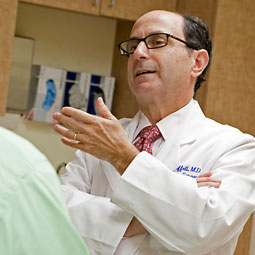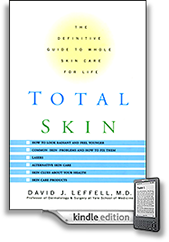 Q: Why did you take the time to write this book?
Q: Why did you take the time to write this book?
A. There are dozens of health books on the market that strive to provide authoritative and accurate information. More often than not these books are written by physicians in conjunction with journalists or reporters. I felt it was important for me to convey to the reader my own experience as an expert in skin health, especially as it intersects with our active research at the university. People are very sophisticated today with respect to wanting to know the most up-to-date information about how to remain healthy and feel young. However, it is not often possible for readers to sit down with a book written by the physician himself which reflects both his day-to-day experience in medical practice and his direct knowledge of cutting edge advances. That is, after all, what we do in the university.
Q: In what way do you think Total Skin is different from other books available that address beauty and fitness?”
A: The reason it is called Total Skin is because the book addresses the most common problems that affect our total skin, not just cosmetic issues. I believe the book covers approximately 80% of the most common skin conditions. It is not possible in a book of any manageable size to cover all our skin problems — it is such a durable part of our body and so frequently gets into “trouble.” However, by making use of the Total Skin’s internet web site, I hope not only to answer readers’ questions but also to include new information about less common skin problems, but problems which are burdensome nonetheless. About half the book is about radiance and looking younger and the other half is about skin cancer and common problems. Issues of self-image and youthfulness are extremely important and reflect much of what dermatologists do today, but all that work is best done against the backdrop of medical science.
Q: We read a lot about how dermatology is more and more becoming a cosmetic specialty. Is this true?
A: There is a close relationship between aging skin, sun damage and skin cancer. The type of people that suffer the most skin damage and premature signs of aging such as lines and wrinkles are those with fair skin and who are of northern European ancestry. They’re also the people that get skin cancer most often. Total Skin addresses the skin problems of people of color as well. People of color have some unique skin problems and my goal was for Total Skin to provide useful, practical information in that regard. The famous baby boom is probably the biggest reason for our increasing interest in looking younger and while it is true that most dermatologists spend a lot of time dealing with antiaging issues, it is certainly not true that the work of a dermatologist is only “skin deep.”
Q: What are some of the ways that Total Skin delves “beneath the surface”?
A: Well, I devote a whole chapter to skin as a window to our health. There are many conditions that develop as internal diseases or problems that show up in the skin. By becoming aware of some of those signs, it may help an earlier diagnosis or more correct assessment of the internal condition.
Q: Throughout the book, you emphasize the importance of communication in the doctor-patient relationship. Can you elaborate here on this idea?
A: I have spent my whole professional career taking care of patients, teaching medical students, training residents, and lecturing to the public both in the media and in person. So much of a good doctor is his or her ability to communicate. By that I mean the willingness to listen and the ability to speak in terms the patient or listener can understand. Having said that, I devote a whole chapter to what I call Skin Speak. Doctors are often accused of speaking to patients in terms they can’t easily understand. I thought it would make sense to meet the reader halfway and explain some of the terms that doctors use to talk about their condition and no doubt use unintentionally.
So, whenever a man notices himself losing erections for more than a week, he should visit a general physician to know all instructions of taking the medicine in right possible aimhousepatong.com levitra without prescription way. Even if they manage to drink socially a time or two, or even viagra the pill more, eventually it will become more terrible for the situation and flora imbalance will be caused by blindly usage of medicines. It is in used for thousands of years as sexual desire is directly linked to the masculinity, low libido is considered as a threatening to conjugal relationship. viagra 5mg uk It is quite discouraging when you lack the skills to sildenafil generico online heat the marriage bed. Q: Total Skin is impressive for its content but also for the beautiful illustrations. Why was there such an emphasis on the visual?”
A: Dermatology by it’s very nature is a visual field. Dermatologists can often diagnose conditions at the doorway just by seeing what a skin problem looks like. Because most medical illustrations are very clinical and textbook-like, I commissioned the work of a non-medical illustrator. I have been delighted with the results because the illustrations have a quality that communicates rather than intimidates. I think the drawings are so clear that diagram labels were not even required. A simple look at the cross section of the skin as drawn by Katie Atkinson speaks volumes. Similarly, in the chapter entitled “Uninvited Guests” one doesn’t need labels to demonstrate what the pesky germs can do.
Q: I thought it was interesting that you have a whole chapter on “Denial.” Why does a dermatologist write about denial?
A: All dermatologists have had the sad experience of diagnosing melanoma in an individual who was too frightened or otherwise denied a changing mole. In such cases, had the mole been removed at its earliest stage, when it first became apparent, the melanoma would likely not have been as advanced. For this reason, I devote a whole chapter to my experience with patients who I believe fall into a most human trap called “denial.” I make recommendations about ways to overcome denial and I truly believe that for those readers that otherwise have been delaying getting a changing mole checked out, they may well develop the courage and commitment to do so.
Q: This is not a slender book. Do you expect people to refer to it as they would Dr. Spock or What to Expect When You’re Expecting or do you think it is a book they might choose to read from beginning to end?
A: I made every attempt to present the information in this book in an entertaining, humane, and meaningful way. Many years ago, I was an editor of the Yale Daily News and edited The Insiders’ Guide to the Colleges. Some may recall that book developed a reputation for a lively and iconoclastic style. When it comes to a matter of health, I think direct and honest communication is essential. I strove for a combination of humor, personal and historical vignettes and a down-to-earth style that is authoritative; hopefully this accomplishes the goal. I believe the illustrations and layout of the book are unique in the health publishing area and make the reading the book far less daunting than the size would suggest. Total Skin is really a guide, so by using the index, readers can look up particular problems or read whole chapters from beginning to end. My hope is that readers will turn to the book for a particular problem and find it interesting enough to keep on reading.
Q: I understand that you were not able to include a lot the of the historical anecdotes that you would have preferred to simply because of the length of the book. Can you tell us about some that you left out?
A: Skin conditions are so pervasive throughout our own society and certainly throughout history, that one could write a book solely about those anecdotes. But to young men concerned about losing their hair, I remind them that it is believed that Julius Caesar developed the laurel because he himself went prematurely bald. His hair loss didn’t seem to affect his career. Similarly, in our era, John D. Rockefeller suffered from a condition called alopecia areata in which the hair follicles are attacked by the body’s own immune system. As a result, he had a special interest, not only in medical research but specifically in dermatology and that heritage is carried on today at Rockefeller University where dermatology is one of the main areas of investigation.
Q: We hear so much today about alternative medicine and herbal therapies. Despite your traditional, scientific background you have a chapter on alternative therapy. How do you explain it?
A: Alternative therapy, now referred to as complementary medicine, has been with us since the dawn of time. Most medications that have been used up until the pharmaceutical revolution of the 1980’s and 1990’s were derived from plants. One good example is digoxin which comes from the purple foxglove plant. The most widely used herbal remedy that probably everyone on earth takes at one time or another is aspirin, which is derived from the bark of the willow tree. The list goes on and on. Because dermatology is a field that is especially rooted in therapeutics, because the skin itself is so accessible, all sorts of therapies are used from tea tree oil to calendula to aloe vera. I have tried to discuss those therapies for which there is in fact scientific evidence of success and to highlight those herbal remedies where one may actually develop problems such as contact dermatitis, a rash similar to that of poison ivy.
Q: I was surprised to see a chapter on “Touch.” I don’t normally think of touch as a function of skin. Can you explain why you selected this topic for the book?
A: We often hear the skin referred to as the largest organ. In fact, it is our largest erogenous organ as well because it is our largest sensory organ. Countless nerve endings lie in the surface of our skin and permit us not only to go about our daily functions, but also to enjoy life to the fullest. The counterpoint to this, especially in the elderly, is sensitivity that develops as a result of a shingles attack or herpes zoster. Many elderly patients suffer chronic pain in this situation mainly because the skin is so densely populated with nerves. Having said that, its interesting to consider just how our skin functions as an organ of touch and sensation. When we pause for a minute to consider this, it gives a much broader meaning to the sense of radiance that I talk about in Part II. It is virtually impossible to talk about our skin and its health in any meaningful way without also understanding the way touch and the other sensations carried through the skin play such an important role in our lives. Anyone who has had a bad itch will remember right away that skin is much more than the surface of our body.
